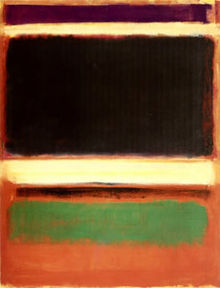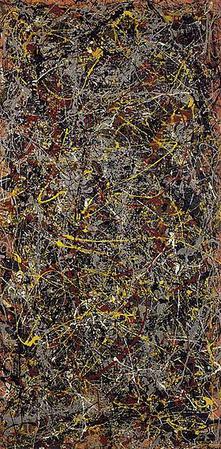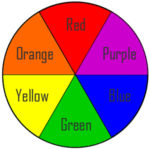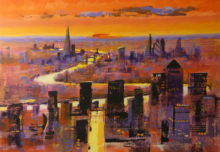ROTHKO AND POLLOCK.
Mark Rothko and Jackson Pollock are two of the new wave of abstract expressionist artists that sprang up in the post second world war period in the United States of America. I wrote in a previous blog about how they inspired my understanding of abstract art way back in the 1960’s, and how their work was like frozen music. According to Wikipedia they were a bit more important and interesting than that.
Born and died.
Mark Rothko born 1903 in Dvinsk in what is now Latvia but was then Russian Empire. His family emigrated to the USA when he was aged 10. Despite doctor’s orders in 1968, Rothko continued to drink and smoke heavily, avoided exercise, and maintained an unhealthy diet. He committed suicide in 1970.
Jackson Pollock born 1912 in Wyoming USA. He was expelled twice from high school. Historians have recently hypothesized that Pollock might have had bipolar disorder. He never left the USA and died in an alcoholic induced single car crash in 1956 aged 44.

‘Magenta, Black, Green on Orange’, by Mark Rothko 1947
Rags and riches.
Pollock and Rothko were both funded by the Federal Art Project. The primary purpose of the FAP, founded in 1935, was to get American artists through the Great Depression. It was created as a relief measure to employ out-of-work artists to create murals, easel paintings, sculpture, graphic art, posters, etc. Artists were paid $23.60 a week.
The project ended in 1943. In the same year Rothko and Pollock both met wealthy art patron Peggy Guggenheim. Peggy Guggenheim had been collecting art in Europe until she was forced to return back to the USA during the Second World War. She was married at the time to the German dada and surrealist artist Max Ernst. They had fled war torn Europe in 1941.
Jackson Pollock’s first solo show was held at Guggenheim’s ‘Art of This Century’ Gallery, New York in 1943. She gave Mark Rothko a solo show at the same gallery in 1945. She bought their art to Europe when she exhibited her collection at the Venice Biennale in 1948. Without Peggy’s generous patronage, it’s doubtful whether the American Abstract Expressionist movement would have survived as it did. Pollock and Rothko went on to do quite well.

Jackson Pollock ‘No. 5’, 1948
Their subsequent art sales.
Pollock and Rothko are numbers 4 and 5 on a list of the highest know prices paid for paintings. Pollock appears again at number 9.
Rothko
The complete catalogue of works on canvas by Rothko comprises 836 paintings.
In early November 2005 Rothko’s 1954 painting Homage to Matisse broke the record for any post-war painting at a public auction, selling for $22.5 million.
In May 2007, Rothko’s 1950 painting White Center (Yellow, Pink and Lavender on Rose) broke this record again, selling at Sotheby’s in New York for $72.8 million.
In May 2012, Rothko’s 1961 painting Orange, Red, Yellow was sold by Christie’s in New York for $86.9 million, setting a new nominal-value record for a post-war painting at a public auction.
In November 2012, his 1954 painting No. 1 (Royal Red and Blue) was sold for an estimated amount of between $35 million and $50 million at a Sotheby’s auction in New York.
In 2014 No6 (Violet Green and Red) sold for $186 million
In May 2015, “Untitled (Yellow and Blue)” sold for $46.5 million at a Sotheby’s auction in New York.
Pollock
In 1973, Number 11, 1952 (also known as Blue Poles) was purchased for the National Gallery of Australia for US $2 million. At the time, this was the highest price ever paid for a modern painting.
In November 2006, Pollock’s No. 5, 1948 became the world’s most expensive painting, when it was sold privately to an undisclosed buyer for the sum of $140 million.
In 2012, Number 28, 1951, one of the artist’s combinations of drip and brushwork in shades of silvery gray with red, yellow, and shots of blue and white, sold at Christie’s, New York, for $20.5 million—$23 million with fees
In 2013, Pollock’s Number 19 (1948) was sold by Christie’s for a reported $58,363,750
In February 2016, Bloomberg News reported that Kenneth C. Griffin had purchased Jackson Pollock’s 1948 painting, Number 17A, for $200 million.
Conclusion
From welfare to wealth via a patron.
Thats nice!
But both artists had died before these huge prices were realised.
It’s a funny old world, isn’t it?




